SAAB 9-3 2005 Owner's Guide
Manufacturer: SAAB, Model Year: 2005, Model line: 9-3, Model: SAAB 9-3 2005Pages: 292, PDF Size: 23 MB
Page 31 of 292
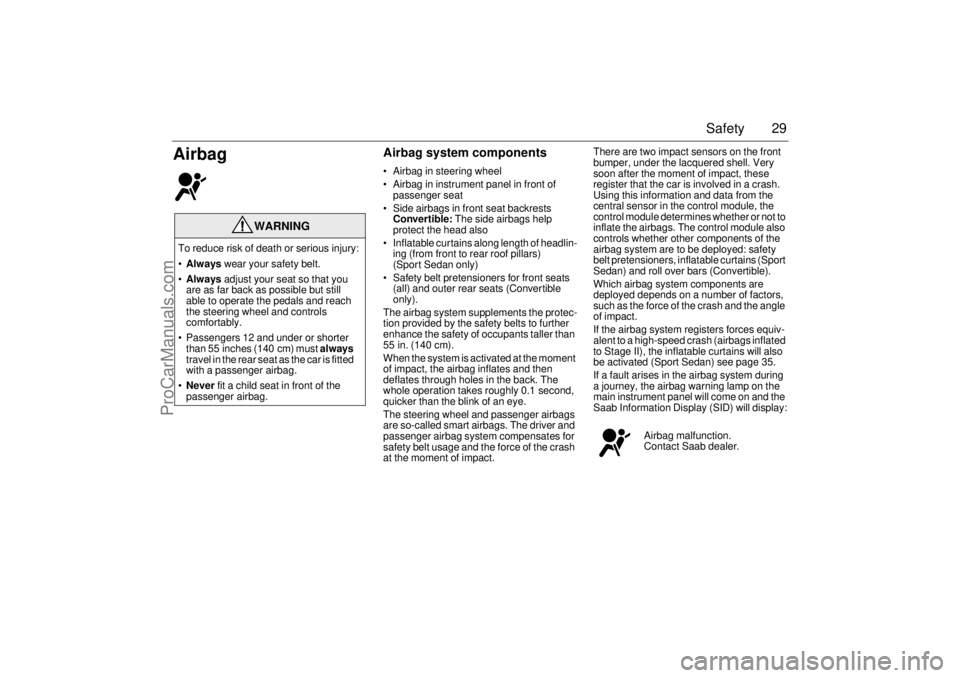
29 Safety
Airbag
Airbag system components Airbag in steering wheel
Airbag in instrument panel in front of
passenger seat
Side airbags in front seat backrests
Convertible: The side airbags help
protect the head also
Inflatable curtains along length of headlin-
ing (from front to rear roof pillars)
(Sport Sedan only)
Safety belt pretensioners for front seats
(all) and outer rear seats (Convertible
only).
The airbag system supplements the protec-
tion provided by the safety belts to further
enhance the safety of occupants taller than
55 in. (140 cm).
When the system is activated at the moment
of impact, the airbag inflates and then
deflates through holes in the back. The
whole operation takes roughly 0.1 second,
quicker than the blink of an eye.
The steering wheel and passenger airbags
are so-called smart airbags. The driver and
passenger airbag system compensates for
safety belt usage and the force of the crash
at the moment of impact.There are two impact sensors on the front
bumper, under the lacquered shell. Very
soon after the moment of impact, these
register that the car is involved in a crash.
Using this information and data from the
central sensor in the control module, the
control module determines whether or not to
inflate the airbags. The control module also
controls whether other components of the
airbag system are to be deployed: safety
belt pretensioners, inflatable curtains (Sport
Sedan) and roll over bars (Convertible).
Which airbag system components are
deployed depends on a number of factors,
such as the force of the crash and the angle
of impact.
If the airbag system registers forces equiv-
alent to a high-speed crash (airbags inflated
to Stage II), the inflatable curtains will also
be activated (Sport Sedan) see page 35.
If a fault arises in the airbag system during
a journey, the airbag warning lamp on the
main instrument panel will come on and the
Saab Information Display (SID) will display:
WARNING
To reduce risk of death or serious injury:
Always wear your safety belt.
Always adjust your seat so that you
are as far back as possible but still
able to operate the pedals and reach
the steering wheel and controls
comfortably.
Passengers 12 and under or shorter
than 55 inches (140 cm) must always
travel in the rear seat as the car is fitted
with a passenger airbag.
Never fit a child seat in front of the
passenger airbag.
Airbag malfunction.
Contact Saab dealer.
ProCarManuals.com
Page 32 of 292
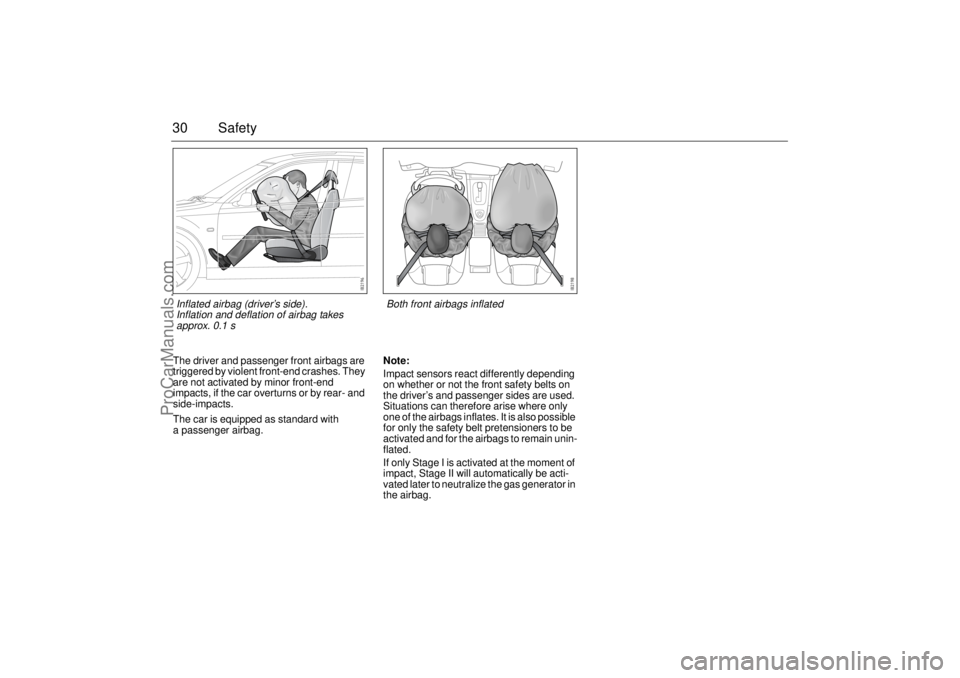
30 SafetyThe driver and passenger front airbags are
triggered by violent front-end crashes. They
are not activated by minor front-end
impacts, if the car overturns or by rear- and
side-impacts.
The car is equipped as standard with
a passenger airbag.Note:
Impact sensors react differently depending
on whether or not the front safety belts on
the driver’s and passenger sides are used.
Situations can therefore arise where only
one of the airbags inflates. It is also possible
for only the safety belt pretensioners to be
activated and for the airbags to remain unin-
flated.
If only Stage I is activated at the moment of
impact, Stage II will automatically be acti-
vated later to neutralize the gas generator in
the airbag.
Both front airbags inflated
Inflated airbag (driver’s side).
Inflation and deflation of airbag takes
approx. 0.1 s
ProCarManuals.com
Page 33 of 292
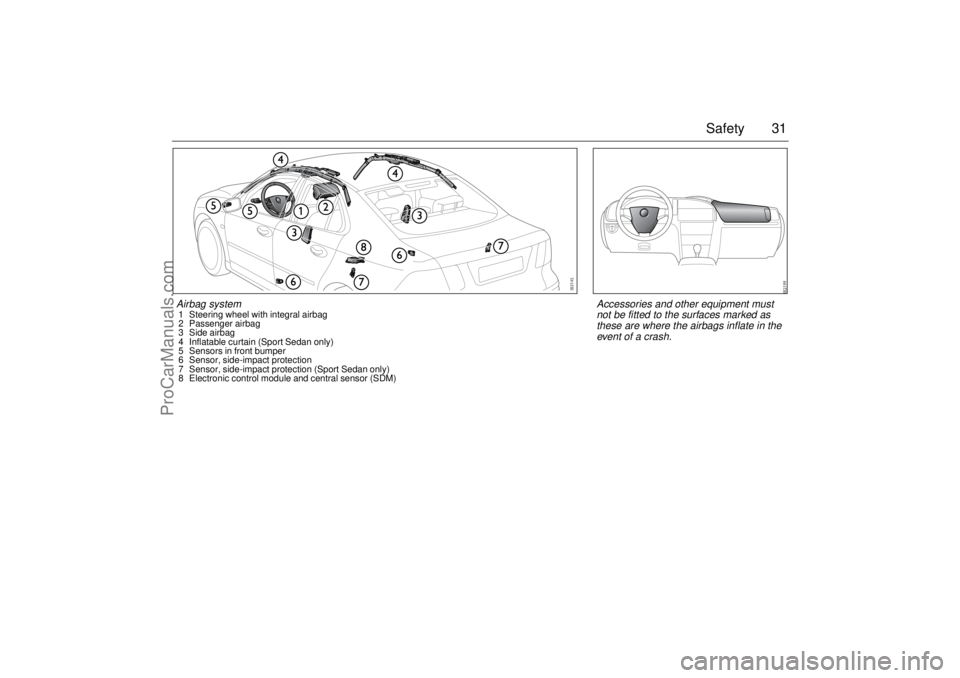
31 Safety
Airbag system1 Steering wheel with integral airbag
2 Passenger airbag
3 Side airbag
4 Inflatable curtain (Sport Sedan only)
5 Sensors in front bumper
6 Sensor, side-impact protection
7 Sensor, side-impact protection (Sport Sedan only)
8 Electronic control module and central sensor (SDM)
Accessories and other equipment must
not be fitted to the surfaces marked as
these are where the airbags inflate in the
event of a crash.
ProCarManuals.com
Page 34 of 292

32 Safety
WARNING
Even if the car is equipped with
AIRBAGS, safety belts must still
always be worn by all occupants.
Note that because an airbag inflates
and deflates extremely rapidly, it will
not provide protection against a
second impact occurring in the same
incident. Always use your safety belt.
Always sit with the whole of your back
in contact with the backrest of the seat,
and with your seat as far back as is
practical.Otherwise you will be thrown
back against the backrest when the
airbag inflates which could cause you
injury or death. The airbag needs
room in which to inflate.
Never attach anything to the steering
wheel or passenger side of the instru-
ment panel, as this could result in
injury if the airbag should inflate. The
same applies to anything you might
have in your mouth, such as a pipe, for
instance.
Some components of the airbag will
be warm for a short time. In some
circumstances the airbag can cause
minor burns or abrasions to the body
when the airbag inflates/deflates.
Never rest your hands or forearms on
the steering-wheel center padding.
If the airbag warning light remains
on after the car has been started or
comes on while you are driving, have
the car checked immediately by an
authorized Saab dealer. The warning
light could signify that the airbags may
not inflate in a crash, or they could
even inflate without a crash. See
page 81.
Fumes are generated by the chemical
reaction that inflates the airbag.
Skin surfaces that show signs of irrita-
tion should be washed with clean
water and a mild soap as soon as
possible.
In the event of eye irritation, flush the
eyes thoroughly with clean water for at
least 20 minutes.
In case of persistent irritation, consult
a doctor.
ProCarManuals.com
Page 35 of 292
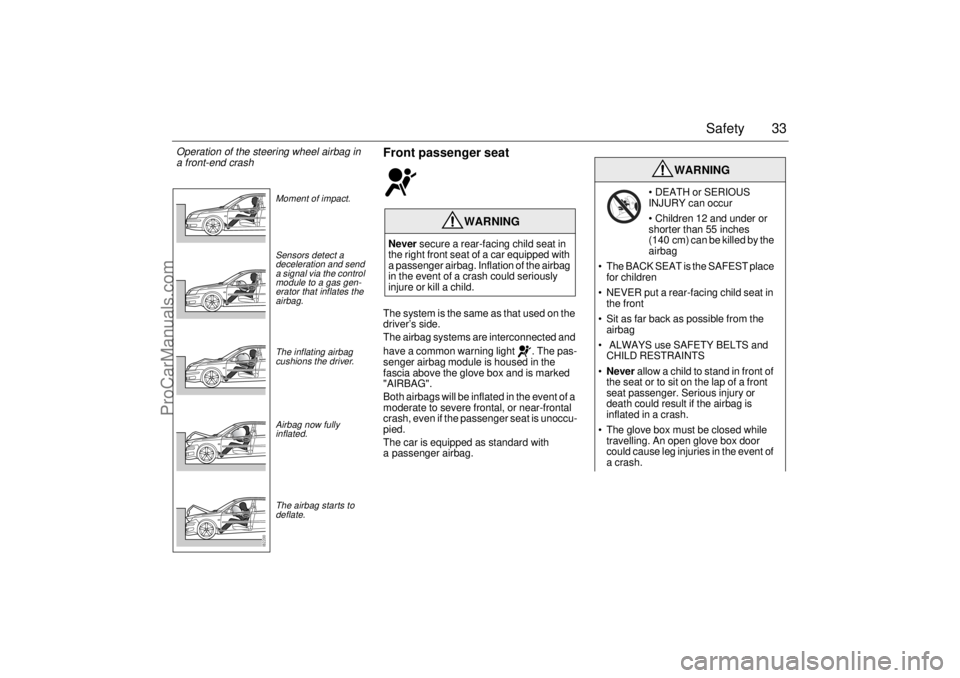
33 Safety
Front passenger seatThe system is the same as that used on the
driver’s side.
The airbag systems are interconnected and
have a common warning light . The pas-
senger airbag module is housed in the
fascia above the glove box and is marked
"AIRBAG".
Both airbags will be inflated in the event of a
moderate to severe frontal, or near-frontal
crash, even if the passenger seat is unoccu-
pied.
The car is equipped as standard with
a passenger airbag.
WARNING
Never secure a rear-facing child seat in
the right front seat of a car equipped with
a passenger airbag. Inflation of the airbag
in the event of a crash could seriously
injure or kill a child.
WARNING
DEATH or SERIOUS
INJURY can occur
Children 12 and under or
shorter than 55 inches
(140 cm) can be killed by the
airbag
The BACK SEAT is the SAFEST place
for children
NEVER put a rear-facing child seat in
the front
Sit as far back as possible from the
airbag
ALWAYS use SAFETY BELTS and
CHILD RESTRAINTS
Never allow a child to stand in front of
the seat or to sit on the lap of a front
seat passenger. Serious injury or
death could result if the airbag is
inflated in a crash.
The glove box must be closed while
travelling. An open glove box door
could cause leg injuries in the event of
a crash.
Operation of the steering wheel airbag in
a front-end crash
Moment of impact.
Sensors detect a
deceleration and send
a signal via the control
module to a gas gen-
erator that inflates the
airbag.
The inflating airbag
cushions the driver.
Airbag now fully
inflated.
The airbag starts to
deflate.
ProCarManuals.com
Page 36 of 292
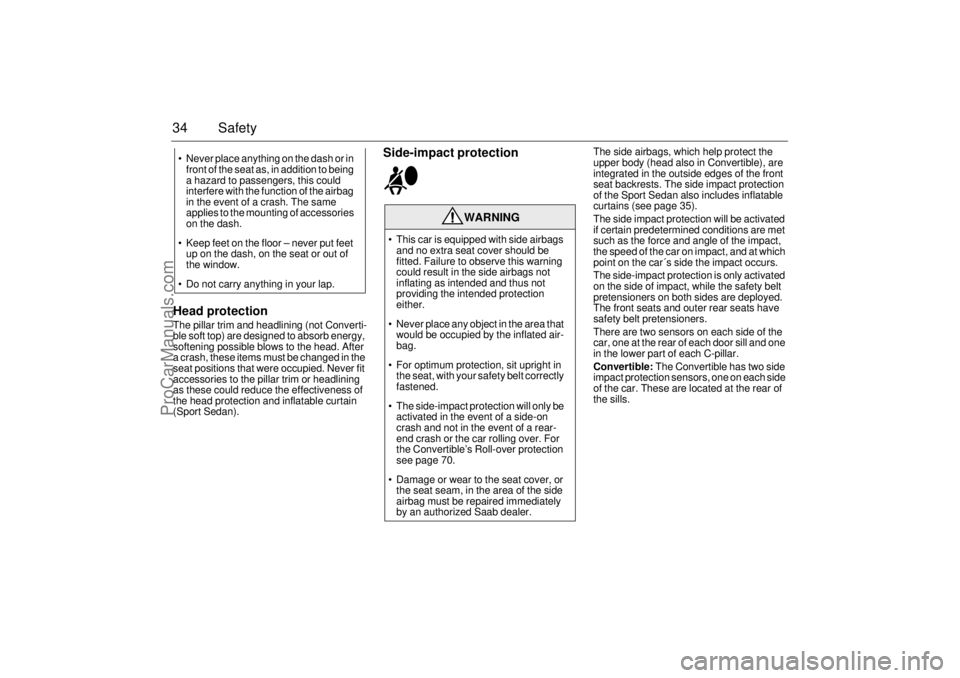
34 SafetyHead protectionThe pillar trim and headlining (not Converti-
ble soft top) are designed to absorb energy,
softening possible blows to the head. After
a crash, these items must be changed in the
seat positions that were occupied. Never fit
accessories to the pillar trim or headlining
as these could reduce the effectiveness of
the head protection and inflatable curtain
(Sport Sedan).
Side-impact protection
The side airbags, which help protect the
upper body (head also in Convertible), are
integrated in the outside edges of the front
seat backrests. The side impact protection
of the Sport Sedan also includes inflatable
curtains (see page 35).
The side impact protection will be activated
if certain predetermined conditions are met
such as the force and angle of the impact,
the speed of the car on impact, and at which
point on the car´s side the impact occurs.
The side-impact protection is only activated
on the side of impact, while the safety belt
pretensioners on both sides are deployed.
The front seats and outer rear seats have
safety belt pretensioners.
There are two sensors on each side of the
car, one at the rear of each door sill and one
in the lower part of each C-pillar.
Convertible: The Convertible has two side
impact protection sensors, one on each side
of the car. These are located at the rear of
the sills. Never place anything on the dash or in
front of the seat as, in addition to being
a hazard to passengers, this could
interfere with the function of the airbag
in the event of a crash. The same
applies to the mounting of accessories
on the dash.
Keep feet on the floor – never put feet
up on the dash, on the seat or out of
the window.
Do not carry anything in your lap.
WARNING
This car is equipped with side airbags
and no extra seat cover should be
fitted. Failure to observe this warning
could result in the side airbags not
inflating as intended and thus not
providing the intended protection
either.
Never place any object in the area that
would be occupied by the inflated air-
bag.
For optimum protection, sit upright in
the seat, with your safety belt correctly
fastened.
The side-impact protection will only be
activated in the event of a side-on
crash and not in the event of a rear-
end crash or the car rolling over. For
the Convertible’s Roll-over protection
see page 70.
Damage or wear to the seat cover, or
the seat seam, in the area of the side
airbag must be repaired immediately
by an authorized Saab dealer.
ProCarManuals.com
Page 37 of 292
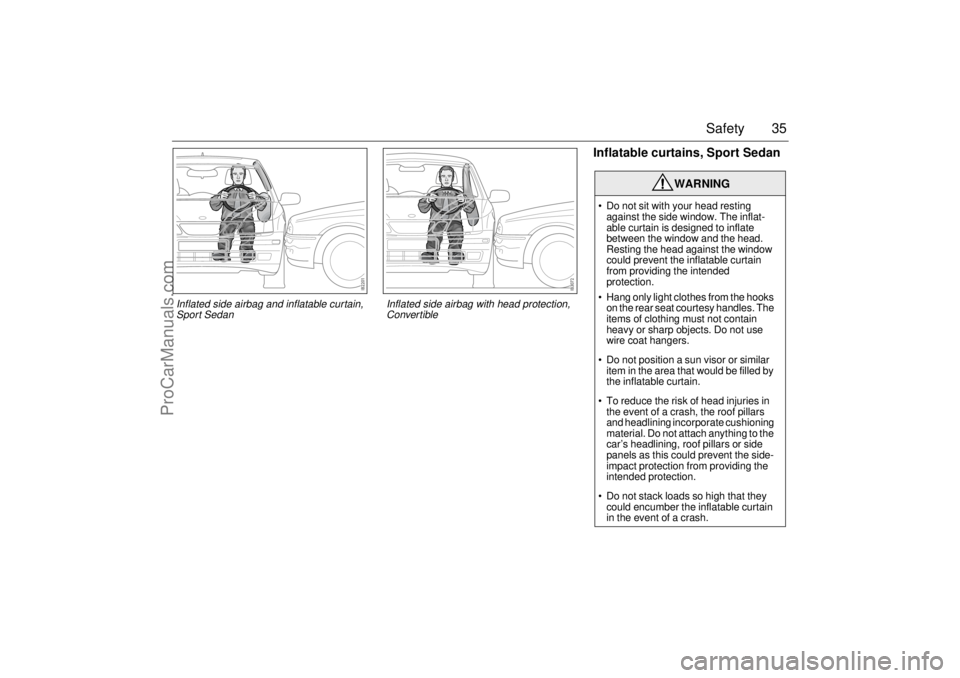
35 Safety
Inflatable curtains, Sport Sedan
WARNING
Do not sit with your head resting
against the side window. The inflat-
able curtain is designed to inflate
between the window and the head.
Resting the head against the window
could prevent the inflatable curtain
from providing the intended
protection.
Hang only light clothes from the hooks
on the rear seat courtesy handles. The
items of clothing must not contain
heavy or sharp objects. Do not use
wire coat hangers.
Do not position a sun visor or similar
item in the area that would be filled by
the inflatable curtain.
To reduce the risk of head injuries in
the event of a crash, the roof pillars
and headlining incorporate cushioning
material. Do not attach anything to the
car’s headlining, roof pillars or side
panels as this could prevent the side-
impact protection from providing the
intended protection.
Do not stack loads so high that they
could encumber the inflatable curtain
in the event of a crash.
Inflated side airbag and inflatable curtain,
Sport Sedan
Inflated side airbag with head protection,
Conver tible
ProCarManuals.com
Page 38 of 292
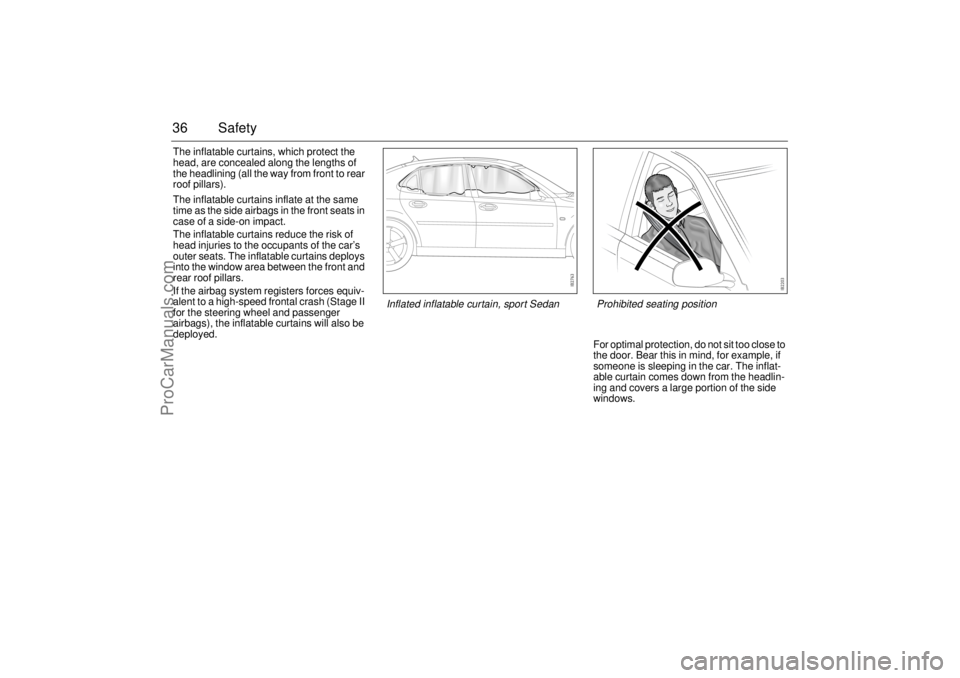
36 SafetyThe inflatable curtains, which protect the
head, are concealed along the lengths of
the headlining (all the way from front to rear
roof pillars).
The inflatable curtains inflate at the same
time as the side airbags in the front seats in
case of a side-on impact.
The inflatable curtains reduce the risk of
head injuries to the occupants of the car’s
outer seats. The inflatable curtains deploys
into the window area between the front and
rear roof pillars.
If the airbag system registers forces equiv-
alent to a high-speed frontal crash (Stage II
for the steering wheel and passenger
airbags), the inflatable curtains will also be
deployed.
For optimal protection, do not sit too close to
the door. Bear this in mind, for example, if
someone is sleeping in the car. The inflat-
able curtain comes down from the headlin-
ing and covers a large portion of the side
windows.
Prohibited seating position
Inflated inflatable curtain, sport Sedan
ProCarManuals.com
Page 39 of 292
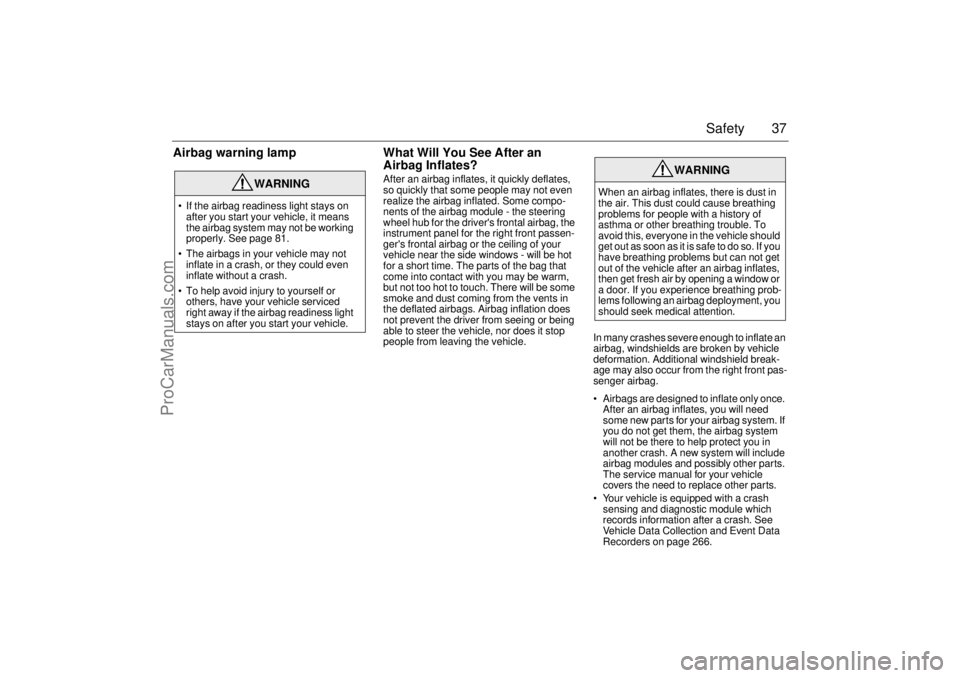
37 Safety
Airbag warning lamp What Will You See After an
Airbag Inflates?
After an airbag inflates, it quickly deflates,
so quickly that some people may not even
realize the airbag inflated. Some compo-
nents of the airbag module - the steering
wheel hub for the driver's frontal airbag, the
instrument panel for the right front passen-
ger's frontal airbag or the ceiling of your
vehicle near the side windows - will be hot
for a short time. The parts of the bag that
come into contact with you may be warm,
but not too hot to touch. There will be some
smoke and dust coming from the vents in
the deflated airbags. Airbag inflation does
not prevent the driver from seeing or being
able to steer the vehicle, nor does it stop
people from leaving the vehicle.In many crashes severe enough to inflate an
airbag, windshields are broken by vehicle
deformation. Additional windshield break-
age may also occur from the right front pas-
senger airbag.
Airbags are designed to inflate only once.
After an airbag inflates, you will need
some new parts for your airbag system. If
you do not get them, the airbag system
will not be there to help protect you in
another crash. A new system will include
airbag modules and possibly other parts.
The service manual for your vehicle
covers the need to replace other parts.
Your vehicle is equipped with a crash
sensing and diagnostic module which
records information after a crash. See
Vehicle Data Collection and Event Data
Recorders on page 266.
WARNING
If the airbag readiness light stays on
after you start your vehicle, it means
the airbag system may not be working
properly. See page 81.
The airbags in your vehicle may not
inflate in a crash, or they could even
inflate without a crash.
To help avoid injury to yourself or
others, have your vehicle serviced
right away if the airbag readiness light
stays on after you start your vehicle.
WARNING
When an airbag inflates, there is dust in
the air. This dust could cause breathing
problems for people with a history of
asthma or other breathing trouble. To
avoid this, everyone in the vehicle should
get out as soon as it is safe to do so. If you
have breathing problems but can not get
out of the vehicle after an airbag inflates,
then get fresh air by opening a window or
a door. If you experience breathing prob-
lems following an airbag deployment, you
should seek medical attention.
ProCarManuals.com
Page 40 of 292
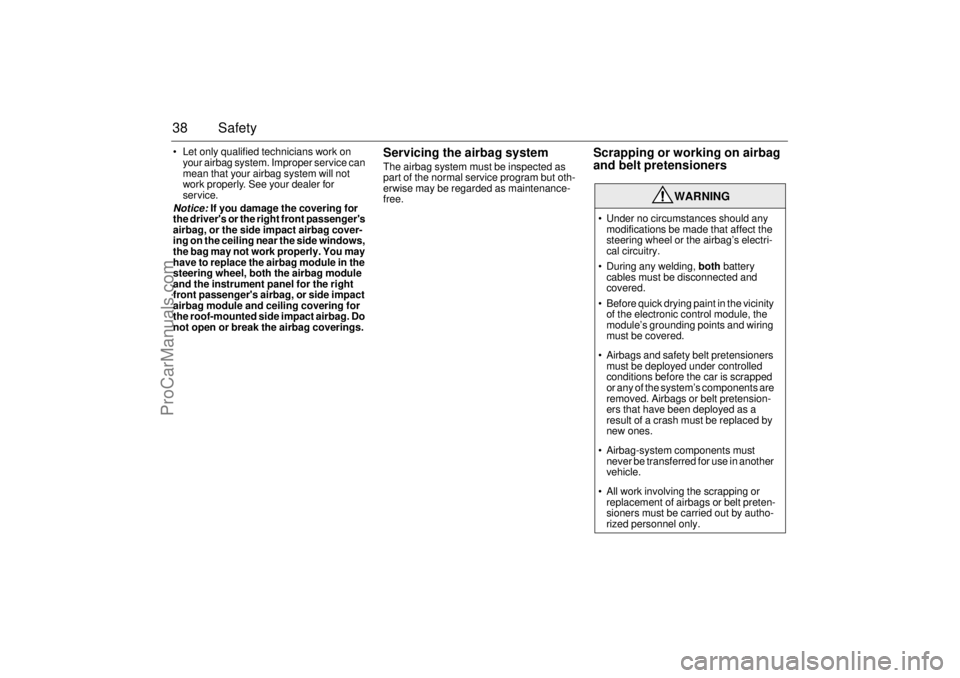
38 Safety Let only qualified technicians work on
your airbag system. Improper service can
mean that your airbag system will not
work properly. See your dealer for
service.Notice:
If you damage the covering for
the driver's or the right front passenger's
airbag, or the side impact airbag cover-
ing on the ceiling near the side windows,
the bag may not work properly. You may
have to replace the airbag module in the
steering wheel, both the airbag module
and the instrument panel for the right
front passenger's airbag, or side impact
airbag module and ceiling covering for
the roof-mounted side impact airbag. Do
not open or break the airbag coverings.
Servicing the airbag systemThe airbag system must be inspected as
part of the normal service program but oth-
erwise may be regarded as maintenance-
free.
Scrapping or working on airbag
and belt pretensioners
WARNING
Under no circumstances should any
modifications be made that affect the
steering wheel or the airbag’s electri-
cal circuitry.
During any welding, both battery
cables must be disconnected and
covered.
Before quick drying paint in the vicinity
of the electronic control module, the
module’s grounding points and wiring
must be covered.
Airbags and safety belt pretensioners
must be deployed under controlled
conditions before the car is scrapped
or any of the system’s components are
removed. Airbags or belt pretension-
ers that have been deployed as a
result of a crash must be replaced by
new ones.
Airbag-system components must
never be transferred for use in another
vehicle.
All work involving the scrapping or
replacement of airbags or belt preten-
sioners must be carried out by autho-
rized personnel only.
ProCarManuals.com